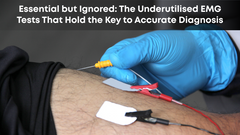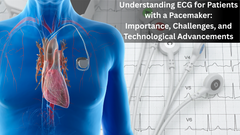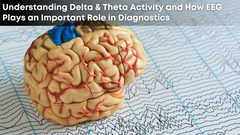Understanding chronic traumatic encephalopathy and how common it is in physical contact sports.?
Physical activity and sports are essential for your physical and mental well-being. However, contact sports—although exhilarating to watch and partake in, come with risks of injury and bodily harm. Every year, thousands of sportspersons involved in contact sports such as boxing, rugby, soccer, hockey, ice hockey and others suffer from injuries to the head and other body parts. Repeated trauma to areas such as the head can also lead to diseases such as CTE or Chronic traumatic encephalopathy (CTE).
What is Chronic traumatic encephalopathy?
Chronic traumatic encephalopathy (CTE) is a neurodegenerative disease associated with repetitive head trauma, particularly in contact sports such as football, soccer, hockey, and boxing.
What causes CTE?
Repeated head injuries and blows to the head cause a buildup of a protein called tau in the brain, which damages brain tissue and affects brain function. Over time, this buildup of tau can cause brain cells to die, leading to the neurological symptoms associated with CTE. CTE is most commonly associated with contact sports, such as football, boxing, ice hockey, soccer, and wrestling. Still, it can also occur from other sources of head trauma, such as military combat or physical abuse.
It is important to note that not everyone who experiences head injuries or trauma will develop CTE. The risk of developing CTE is higher for individuals who have experienced repeated head injuries, particularly if they have not allowed sufficient time for the brain to heal between injuries. The risk may also be greater for individuals who have a genetic predisposition to the condition.
What are the main symptoms of CTE
CTE can lead to a range of neurological symptoms, including:
- >Memory loss
- >Impaired judgment
- >Impulsive behaviour
- >Depression
- >Anxiety
- >Aggression
- >Difficulty with balance and coordination
- >Parkinsonism (a group of movement disorders similar to Parkinson's disease)
The symptoms of CTE can take years or even decades to develop and can progressively worsen over time.
The impact of CTE on sportspersons
Studies have found evidence of CTE in the brains of many former football players, with one study reporting that 110 out of 111 deceased NFL players had evidence of CTE in their brain tissue. Similar studies of other contact sports have also reported cases of CTE in former athletes. Studies have shown that professional boxers are at higher risk for developing CTE due to the repetitive blows to the head that occur during bouts.
Does CTE affect females differently?
A study published in the Journal of Neurotrauma in 2014 found that female soccer players had a higher risk of experiencing concussions than male soccer players, with a concussion rate of 6.3 per 10,000 athlete exposures for females compared to 3.4 per 10,000 athlete exposures for males. Another study published in the same year in the journal Brain Injury found that female athletes in contact sports such as soccer, basketball, and lacrosse were more likely to suffer concussions than males in the same sports.
A more recent study published in 2020 in the journal JAMA Network Open examined the brains of female athletes who had participated in soccer, basketball, and/or lacrosse and had died. Of the 49 brains analyzed, 17 showed evidence of CTE, and all CTE cases were diagnosed as stage II or III, indicating a moderate to severe level of disease.
Diagnosing CTE
Diagnostic evaluations of CTE may include a comprehensive medical history, neurological examination, cognitive testing, imaging studies, and blood tests. The healthcare professional may also inquire about the individual's history of head injuries, including the number, severity, and duration of the injuries, as well as any other factors that may have contributed to the development of symptoms. However, the only way to make a definitive diagnosis of CTE is post-mortem by examining the brain tissue under a microscope.
How can you prevent CTE?
Preventing Chronic Traumatic Encephalopathy (CTE) involves minimizing head trauma and promoting proper head protection during activities that may pose a risk of head injury. Here are some strategies that can help prevent CTE:
>Wear appropriate protective gear: Wear helmets and other protective gear designed for the specific activity you are participating in, such as football, hockey, or cycling. Make sure that the gear fits well and is maintained.
>Follow the rules: Follow the rules and regulations of the sport or. This can help reduce the risk of head injuries from illegal or unsafe play.
>Strengthen your neck muscles: Strengthening the muscles of the neck can help reduce the risk of head injury by improving the ability to absorb and resist impact.
>Limit exposure to head injury: Limit the number and severity of head injuries you experience. For example, avoid engaging in high-risk activities or reduce participation in activities that may pose a risk of head injury.
>Seek medical attention for head injuries: Seek medical attention immediately if you experience a head injury or any symptoms related to a head injury, such as headache, dizziness, or confusion. Allow sufficient time for the brain to heal between injuries.
>Educate yourself and others: Educate yourself and others about the signs and symptoms of head injury and the importance of taking head injuries seriously.
If you suspect that you or someone you know may have CTE or are experiencing symptoms related to head injuries. In that case, it is crucial to seek medical attention from a qualified healthcare professional.
Final thoughts
Athletes and sportspersons engaged in contact sports are at grave risk of developing CTE, and the disease can significantly impact the lives of athletes, both during their playing careers and beyond. Ensuring that athletes adhere to the game's regulations and wear protective equipment can go a long way in reducing the impact of this disease.
Clarity Medical’s BrainTech EEG
Clarity Medical is a Mohali-based manufacturer of high-quality medical diagnostic equipment appreciated worldwide for its efficiency and reliability. Clarity Medical's commitment to quality and reliability has ensured that its EEG devices, remote patient monitors and other ground-breaking telemedicine solutions can help medical institutions maintain world-class patient care at all times.












